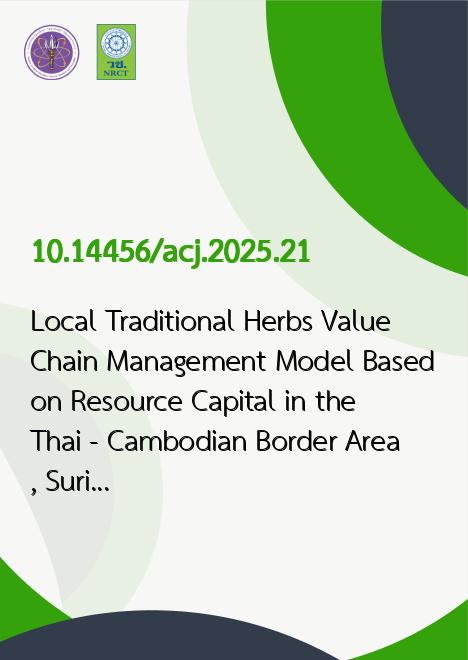
|
Local Traditional Herbs Value Chain Management Model Based on Resource Capital in the Thai - Cambodian Border Area, Surin Province |
|---|---|
| รหัสดีโอไอ | |
| Creator | Ubonwan Suwannapusit |
| Title | Local Traditional Herbs Value Chain Management Model Based on Resource Capital in the Thai - Cambodian Border Area, Surin Province |
| Contributor | Chonnatcha Kungwansupaphan, Nisanart Kaewwinud |
| Publisher | The Office of Arts and Culture, Surindra Rajabhat University |
| Publication Year | 2568 |
| Journal Title | Arts and Culture Journal of the Lower Moon River |
| Journal Vol. | 14 |
| Journal No. | 2 |
| Page no. | 281-294 |
| Keyword | Value Chain Management, Traditional Herbal, Resource Capital |
| URL Website | https://so07.tci-thaijo.org/index.php/acj |
| Website title | วารสารศิลปะและวัฒนธรรมลุ่มแม่น้ำมูล |
| ISSN | ISSN 2822 - 0617 (Online);ISSN 2822 - 1141 (Print) |
| Abstract | This research aimed to study the value chain management model for indigenous medicinal herbs based on resource capital along the Thai - Cambodian border in Surin Province. Data was collected from 29 key informants involved in the development of target medicinal herbs in Surin, through interviews and focus group discussions. The data were analyzed through relational linkage and descriptive analysis. The research findings revealed that the value chain management model for indigenous medicinal herbs functions as a continuous chain, where each activity contributes incrementally to the added value of the final product from the acquisition of raw materials through production processes to the final product delivered to end consumers at a price they are willing to pay. The value chain comprises both primary and support activities and can be divided into three main stages 1) Upstream stage : Involving input suppliers and herb growers, who may operate individually or in groups, either informally or through formal cooperatives, 2) Midstream stage : Including herb collectors who add value through initial processing, such as drying, before selling to hospitals or external consumers, and 3) Downstream stage : Referring to purchasing agents who distribute the herbs to entrepreneurs and wholesalers, who then deliver the products to retailers and ultimately to final consumers. The transfer of knowledge regarding the value chain of indigenous medicinal herbs has led to the development of a localized, resource-based value chain management model that enhances the strength and competitiveness of the regional herbal industry. |